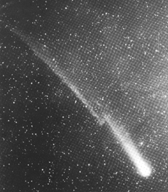Parker's Theory
No one gave a good reason why this "particle radiation" should exist, until Eugene Parker of the University of Chicago in 1958 tried to derive the equilibrium structure of the corona.
The corona, like the Earth's atmosphere, is held down by the Sun's gravity. In any atmosphere, the average velocity of atoms, molecules and ions depends on their temperature. Individual velocities are spread out around this average, and a few particles are always fast enough to "evaporate" and escape the restraining gravity.
Our Moon's gravity is weak, 1/6 of the Earth's at the Moon's surface, and it is believed that if it ever had any atmosphere, it would have evaporated long ago. The stronger gravity of Earth, on the other hand, has managed to hold on to a substantial atmosphere, on which all terrestrial life depends.
The Sun's gravity is much stronger, but a million-degree atmosphere is too much for it. If the Sun's corona behaved like the Earth's atmosphere, it would gradually get cooler with increasing distance, with a cool top in equilibrium with the surrounding space. Parker however found that the conduction of heat interfered with such an equilibrium and instead another solution suggested itself, in which the topmost layers of the corona flowed away from the Sun at a velocity like that of Biermann's "corpuscular radiation." The flow was named "solar wind" and its existence was later confirmed by instruments aboard spacecraft.
The solar wind shapes the Earth's magnetosphere and supplies energy to its many processes. Its density at the Earth's orbit is around 6 ions per cubic centimeter--far, far less than that of the "best vacuum" obtainable in labs on Earth. The distribution of ions in the solar wind generally resembles the distribution of elements on the Sun-- mostly protons, with 5% helium and smaller fractions of oxygen and other elements. (Of course it has electrons too, balancing the positive charge of the ions and keeping the plasma electrically neutral.) All this flows away from the Sun with a mean speed of about 400 km/sec, and as shown by the Voyager 2 space probe, this flow extends past the outermost planets, more than 30 times more distant from the Sun than Earth, and it probably continues much further than that.
The Interplanetary Magnetic Field
The regions where the solar wind starts are immersed in the Sun's magnetic field (though perhaps in regions where that field is relatively weak). However, plasma outflows from regions of magnetic fields can spread those fields to wherever they arrive. This happens by "field line preservation," a property derived from the equations of an ideal plasma. By those equations, in an ideal plasma ions and electrons which start out sharing the same magnetic field line continue to do so later on, as if the line were a (deformable) wire and the particles beads threaded by it.
If the energy of the magnetic field is dominant, its field lines keep their shapes and particle motion must conform to them; that is what happens in the radiation belts. On the other hand, if the energy of the particles is dominant--that is, if the field is weak and the particles dense--the motion of the particles is only slightly affected, whereas the field lines are bent and dragged to follow that motion. That is the case with the solar wind.
Imagine a field line extending from the bulk of the Sun to the upper corona. The particles at its "roots" stay with the Sun, but those in the high corona flow out with the solar wind, to the Earth's orbit and far beyond. All that time (under ideal conditions--a fair approximation) the same field line continues to link both groups. Thus some solar field lines will extend to the Earth and further out, producing the interplanetary magnetic field (IMF). It is the IMF that allows the solar wind to "pick up" the ions in a comet's ion tail, as it also did to an "artificial comet" produced in a 1985 experiment (see positive ions, "clouds of barium ions"). As will be seen, the IMF plays a major role in linking the
magnetosphere to the solar wind.
A graphic exercise on tracing the shape of interplanetary magnetic field lines is presented in the next section.
Questions from Users:
*** Use of solar wind for space propulsion
*** Any connection between Solar Wind and Solar Flares?
*** Can anything solid be carried by the solar wind?
***
The Speed of the Solar Wind
***
The solar wind and solar escape velocity
***
Solar wind effects on our lives
***
A solar wind contribution to
global warming?
***
Can upper atmosphere atoms join solar wind?
|

